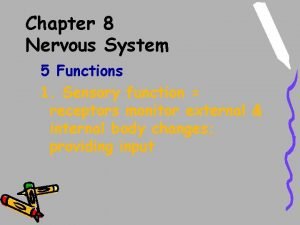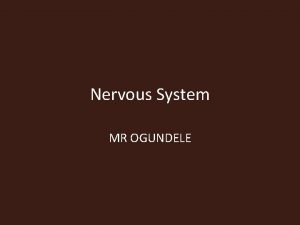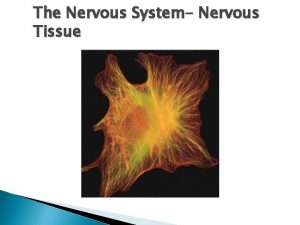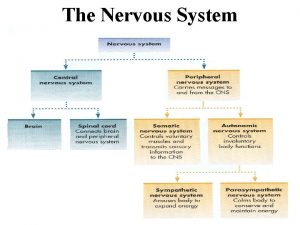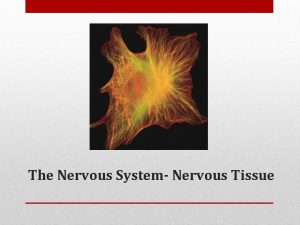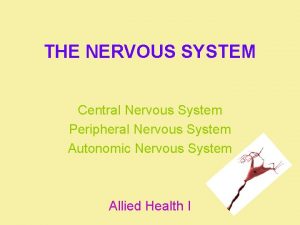Nervous System Functions of the Nervous System 1

























- Slides: 25

Nervous System

Functions of the Nervous System � 1. Sensory Input: Internal and External Stimuli �EX. Sight, vision, hearing, taste, smell, touch, pain, body position, temperature. �Also those stimuli processed at an unconscious level, such as, blood p. H & blood pressure, � 2. Integration: Central nervous system processes sensory input and responds. �It may store info as a memory.

� 3. Control of Muscles and Glands: May control the skeletal muscles to contract when stimulated. Controls the major movements. �Also controls the cardiac muscle, smooth muscle and major glands.

� 4. Homeostasis: The nervous system detects interprets and responds to changes in our internal and external environments. �The nervous system can stimulate or inhibit the activities of other systems to help maintain a constant internal environment. � 5. Mental Activity: conscious thinking, memory & emotions.

Parts of the Nervous System �Central Nervous System or CNS: Consists of the Brain and Spinal Cord. � 12 pairs of Cranial Nerves �Originate from the brain � 31 pairs of spinal nerves. �Originate from the spine.

Parts of the Nervous System �Peripheral Nervous System or PNS: Consists of sensory receptors and nerves. �Sensory Receptors detect the senses such as pain, touch, heat, light, sound, odors etc. �They are located in the skin, muscles, joints, internal organs and sensory organs such as the eyes and ears.

Pripheral Nervous System �Divided into two parts: � 1. Sensory or Afferent Division: �This sends signals from the sensory receptors to the CNS. � 2. Motor or Efferent Division: �This transmits signals from the CNS to the effector organs, such as muscles or glands. The motor division can be further divided into the somatic motor and the Autonomic nervous system.

Somatic Motor Nervous System �This system transmits action potential from the CNS to the skeletal muscles.

Parts of the Nervous System �Nerve Cell or Neuron: A bundle of axons and their Sheaths. Nerves transmit electrical signals called action potentials.

Parts of the Nervous System �Cell Body or Soma: This is the large area of the Neuron that contains the nucleus and the other organelles. �The nerve cells contain many Golgi Bodies and an extensive network of Rough Endoplasmic Reticulum.

Parts of the Nervous System �Axon: A long cell process extending from the cell body of the neuron. The trigger zone is the part of the nerve cell where the axon begins and the action potential is generated. �Axons are often referred to as nerve fibers. The axon can branch off Known as collateral axons, or remain on single fiber.

Parts of the Nervous System �Axons carry impulses from the cell body to other nerve cells. The junction happens at the Axon Terminals or Presynaptic Terminal. �The junction between two nerve cells is called the Synapse.

Parts of the Nervous System �Dendrites: short, highly branched areas that receive the action potential from other neurons. �The action potential is carried by Neurotransmitters across the Synaptic Clef.

Myelin Sheath �This is the covering of the Axon or the plasma membrane of the Schwann Cells. � The myelin protects the and electrically insulates the neuron. �Also allows the action potential to move faster & easier. �These are White in color, so heavily myelated cells appear as White Matter.

Nodes of Ranvier. �The bare area of the Axon. Oligodenrocytes do cross these areas but do not wrap around multiple times. .

Unmyelinated areas. �Grey matter. The oligodendrocytes surounds each axon but does not wrap around it multiple times.

Parts of the Nervous System �Neurotransmitters: These are chemicals that cross the synapse. They will either stimulate or inhibit the postsynaptic cell. �The action potential in the presynaptic terminal or axon terminal cause a voltage increase allowing ions such as Ca++ to enter the cell. This voltage jump causes the release of the neurotransmitters. �

Some Types of Neurotransmitters. �Acetylcholine: Excitatory Effect in the CNS, Inhibitory in the ANS. EX Myasthenia Gravis the inability for the muscle to respond to the nervous system. �Serotonin: Inhibitory �Dopamine: Excitatory & Inhibitory �Norepinepherine: Excitatory �Gamma-Amino Butyric Acid (GABA): Inhibitory �See Page 286, 287, 288 & 289

Types of Neurons �Sensory or Afferent Neurons conduct action potentials toward the CNS. �Motor or Efferent Neurons conduct action portential from the CNS toward the muscle or gland. �Interneurons or Association Neurons: conduct action potential from one neuron to another within the CNS.

Three major categories of neurons �Multipolar Neurons: These have many dendrites and one axon. Found in the CNS and most motor neurons. �Bipolar Neurons: one Dendrite and one Axon. Found in some sensory organs. Retina of the Eye and nasal cavity. �Unipolar Neurons: These have a single process that extends from the cell body. the process divides into two branches. One to the CNS the other to the peripheral nervous system. Most sensory neurons are this type.

Glial Cells of the CNS �Nonneural cells or Glial Cells. These are about ½ of the Brains weight. And are major supporting cells of the CNS. �Function: � 1. To make a permeable barrier between blood and neurons. � 2. phagocytize foreign substances. � 3. produce cerebrospinal fluid � 4. produce myelin Sheaths around the axon.

Astrocytes �Star shaped glial cells. These are major supporting cells of the CNS. �They regulate the extracellular composition of the brain fluid, by forming a blood brain barrier, which determines what substances can pass from the blood into the nervous tissue of the brain.

Ependymal Cells �These line the ventricles of the brain and central canal of the spinal cord. They may be lines with cilia to help move the cerbral spinal fluid though the brain cavities.

Microglia �Glial cells that become mobile and phagocytic in response to damage or inflammation, infection, trama or stroke.

Oligodendrocytes �These form the myelin sheaths. �They can wrap many times areound the axon.
 Neural circuits the organization of neuronal pools
Neural circuits the organization of neuronal pools Sensory input and motor output
Sensory input and motor output Fundamentals of the nervous system and nervous tissue
Fundamentals of the nervous system and nervous tissue What are the three basic functions of the nervous system
What are the three basic functions of the nervous system 5 functions of the nervous system
5 functions of the nervous system Nervous system and digestive system
Nervous system and digestive system Endocrine system vs nervous system
Endocrine system vs nervous system Mechanism of action of hormones
Mechanism of action of hormones Endocrine system
Endocrine system Hát kết hợp bộ gõ cơ thể
Hát kết hợp bộ gõ cơ thể Lp html
Lp html Bổ thể
Bổ thể Tỉ lệ cơ thể trẻ em
Tỉ lệ cơ thể trẻ em Voi kéo gỗ như thế nào
Voi kéo gỗ như thế nào Glasgow thang điểm
Glasgow thang điểm Chúa yêu trần thế
Chúa yêu trần thế Môn thể thao bắt đầu bằng chữ đua
Môn thể thao bắt đầu bằng chữ đua Thế nào là hệ số cao nhất
Thế nào là hệ số cao nhất Các châu lục và đại dương trên thế giới
Các châu lục và đại dương trên thế giới Công thức tính thế năng
Công thức tính thế năng Trời xanh đây là của chúng ta thể thơ
Trời xanh đây là của chúng ta thể thơ Mật thư anh em như thể tay chân
Mật thư anh em như thể tay chân Phép trừ bù
Phép trừ bù Phản ứng thế ankan
Phản ứng thế ankan Các châu lục và đại dương trên thế giới
Các châu lục và đại dương trên thế giới Thể thơ truyền thống
Thể thơ truyền thống




